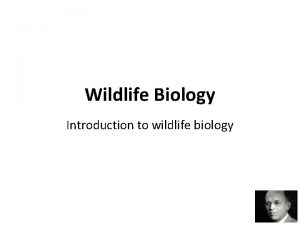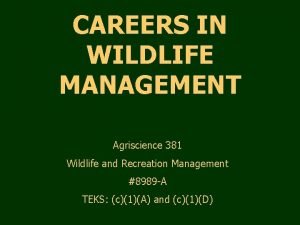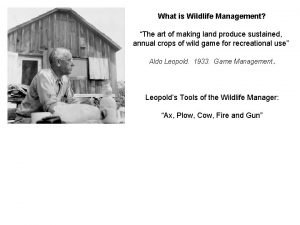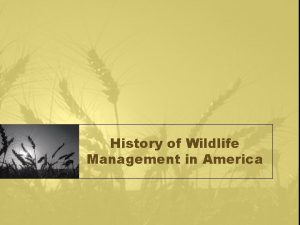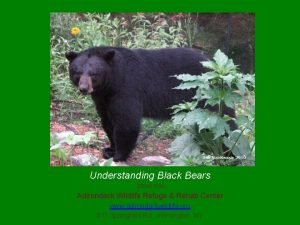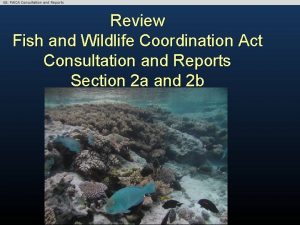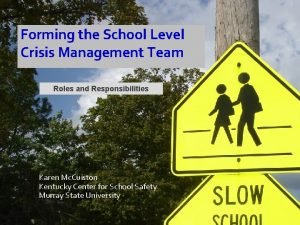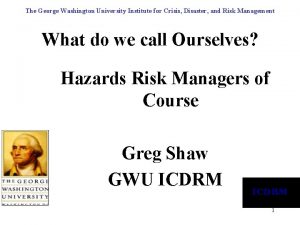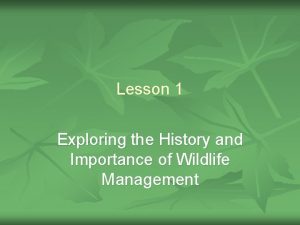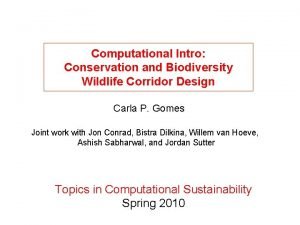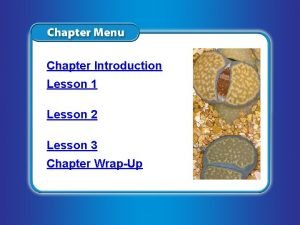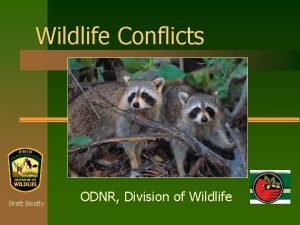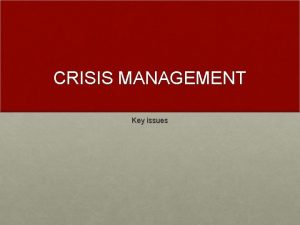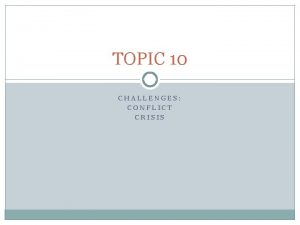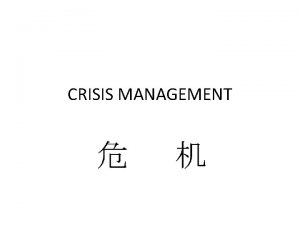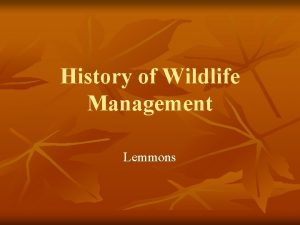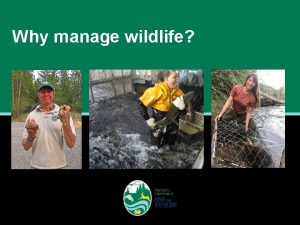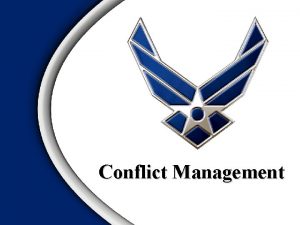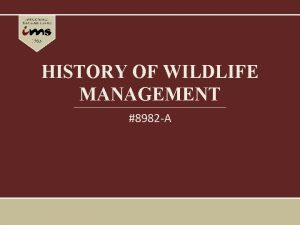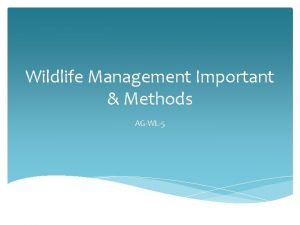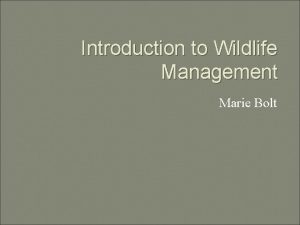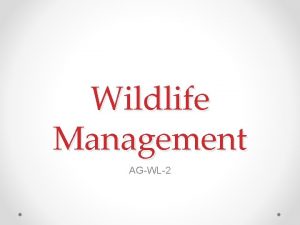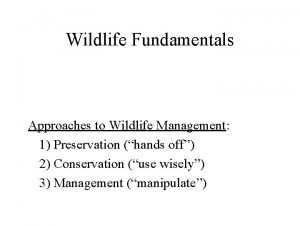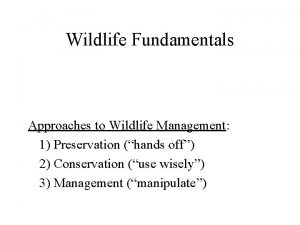Crisis And Conflict Management Wildlife and Human Conflict

























- Slides: 25

Crisis And Conflict Management

Wildlife and Human Conflict & Understanding Conflict Management Styles Lecture 27 2

Habitat Destruction • Habitats can be destroyed by natural causes, human actions, and pollution – Natural causes: lightning strikes, fires, hurricanes, earthquakes, and ice storms – Human actions: building highways, subdivisions, factories, agricultural practices – Pollution: chemical contaminants, landfills, smoke, smog, and acid rain destroy habitat 3

Human Impact on Wildlife • • Harvest: hunting and fishing Introduce exotic species Fire suppression Campsite and trail development Grazing Mining Predator control Harassment 4

What is Human-Wildlife Conflict? • Conflict occurs when wildlife requirements overlap the requirements of human populations • Species most exposed to conflict are also shown to be more prone to extinction due to human-induced mortality • Impact human welfare and have economic and social costs 5

Human-Wildlife Conflict Driving Forces • Human Population Growth – As populations increase, settlements expand leading to wildlife encroachment • Land Use Transformation – Consequence of increasing demand for land, food production, energy, and raw materials • Species habitat loss, degradation, and fragmentation – Interconnected with population growth and land use change 6

Human-Wildlife Conflict Driving Forces • Increasing Livestock Populations – Increased densities in livestock production create an overlap of diets and forage competition with wild herbivores • Results in over grazing and decline of local herbivore • Abundance and distribution of wild prey – Abundance prey leads to increased predation – Decrease prey leads to diet change of predator which then focuses on livestock • Climatic factors – Seasonal changes in rainfall or temperatures leads to diet and habitat change for animals 7

Human-Wildlife Conflict Indicators • Species Distribution – Species shift away from human activity may indicate displacement – Species shift towards human activity may indicate attraction of opportunistic species • Abundance – Increased abundance may indicate attraction of opportunistic species – Decreased abundance may indicate displacement of species 8

Human-Wildlife Conflict Indicators • Population Trends – Increasing population trends may indicate attraction for opportunistic species – Decreasing population trends may indicate displacement • Species Diversity – Diversity measures combine information on the number of species and abundance – A decrease in diversity may indicate some species have been displaced or eliminated – Does not reflect replacement of one species with another 9

Human-Wildlife Conflict Indicators • Species composition – Change in composition may indicate displacement of species sensitive to human presence – May also indicate attraction if the species present are opportunistic • Species Richness – A decrease may indicate displacement of species sensitive to human presence – An increase may indicate that opportunistic species have moved into an area – Does not reflect the replacement of one species by another 10

Human-Wildlife Conflict Prevention • Lethal methods of control should not be first response • Public education is needed • Improved land use planning 11

Understanding Conflict Management Styles 12

What is a conflict management style and why do I need to know this? • Conflict Management Style: Form of behavior that a person practices in response to conflict with others • When living and interacting with others on campus, you need to know how to resolve issues in different situations. 13

Conflict: Where does it come from? • Goals • Personality conflicts • Scarce resources • Styles • Values 14

The Positive Side of Conflict • Conflict can teach you to make the most of each situation and use it as a learning opportunity or a leadership opportunity. • You can also use it as an opportunity to transform the situation into something better. 15

Five Styles of Conflict Management You will experience some form of internal or external conflict while living with roommates at some point in your college career. Understanding how you handle conflict is important in helping you decide how to deal with stress and manage certain situations. 16

Accommodating People who accommodate are unassertive and very cooperative. • Give in during a conflict • Acknowledge they made a mistake/decide it was no big deal • Put relationships first, ignore issues, and try to keep peace at any price • Effective when the other person or party has a better plan or solution 17

Avoiding People who avoid conflict are generally unassertive and uncooperative. • Avoid the conflict entirely or delay their response instead of voicing concerns • Can create some space in an emotional environment • Not a good long-term strategy 18

Collaborating Collaborators are both assertive and cooperative. • Assert own views while also listening to other views and welcoming differences • Seek a “win-win” outcome • Identify underlying concerns of a conflict • Create room for multiple ideas • Requires time and effort from both parties 19

Competing People who approach conflict in a competitive way assert themselves and do not cooperate while pursuing their own concerns at another’s expense. • Takes on a “win-lose” approach where one person wins and one person loses • Does not rely on cooperation with the other party to reach outcome • May be appropriate for emergencies when time is important 20

Compromising Compromisers are moderately assertive and moderately cooperative. • Try to find fast, mutually acceptable solutions to conflicts that partially satisfy both parties • Results in a “lose-lose” approach • Appropriate temporary solution • Considered an easy way out when you need more time to collaborate to find a better solution 21

Which one is best? There is no BEST way to handle conflict. Each conflict is different and requires a different response. As a society, we teach: “Two heads are better than one. ” (Collaborating) “Kill your enemies with kindness. ” (Accommodating) “Split the difference. ” (Compromising) “Leave well enough alone. ” (Avoiding) “Might makes right. ” (Competing) 22

Conclusion • Different conflict management styles may be used when faced with different situations. • Knowing yourself and fully understanding each situation will help you understand the conflict management style needed. • Try a scenario-based approach to test the effectiveness of different approaches to specific situations. 23

Summary • • Habitat Destruction Human impact on wildlife Understand conflict management styles Calibration Competing Compromising Conclusion 24

Thank you 25
 Myasthenic crisis vs cholinergic crisis ppt
Myasthenic crisis vs cholinergic crisis ppt Manipulative management wildlife
Manipulative management wildlife Objectives of wildlife management
Objectives of wildlife management Careers in wildlife management
Careers in wildlife management Wildlife management as an art
Wildlife management as an art History of wildlife management
History of wildlife management Adk wildlife refuge
Adk wildlife refuge Natural vegetation and wildlife of karnataka
Natural vegetation and wildlife of karnataka Fish and wildlife coordination act
Fish and wildlife coordination act Arctic national wildlife refuge oil drilling pros and cons
Arctic national wildlife refuge oil drilling pros and cons Crisis management team in schools
Crisis management team in schools Ford and firestone crisis management
Ford and firestone crisis management George washington crisis management
George washington crisis management Mit crisis management and business continuity
Mit crisis management and business continuity Snowfall torrente
Snowfall torrente Animal depletion
Animal depletion Wildlife topics for presentation
Wildlife topics for presentation Basic requirements of wildlife
Basic requirements of wildlife Shillapoo wildlife area
Shillapoo wildlife area History of wildlife conservation
History of wildlife conservation Wildlife corridor design
Wildlife corridor design Wildlife reproduction
Wildlife reproduction Cascade mountains wildlife
Cascade mountains wildlife Odnr division of wildlife
Odnr division of wildlife Boreal shield vegetation
Boreal shield vegetation Spoil wildlife
Spoil wildlife

